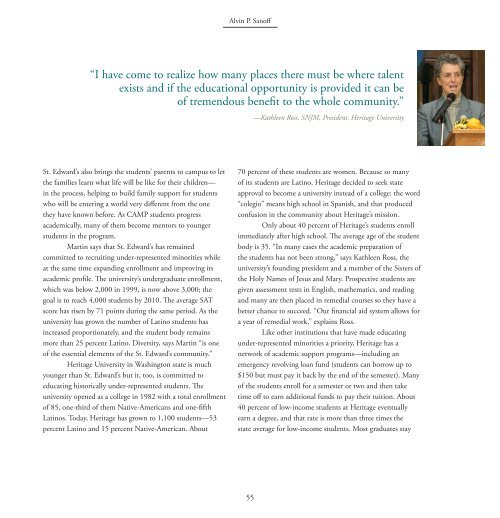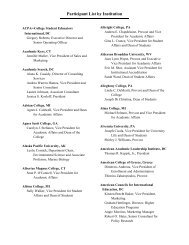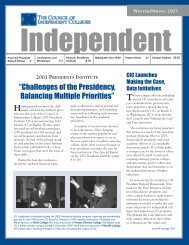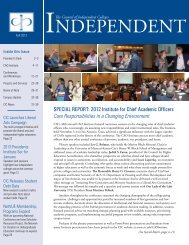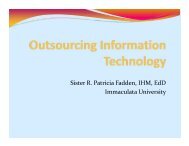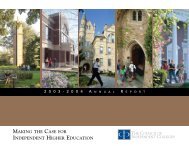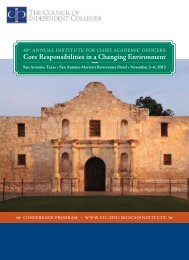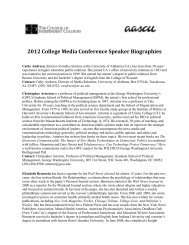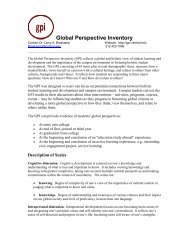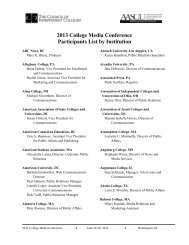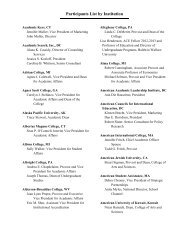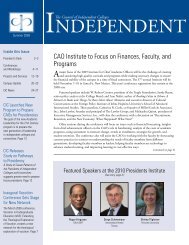Meeting the Challenge: - The Council of Independent Colleges
Meeting the Challenge: - The Council of Independent Colleges
Meeting the Challenge: - The Council of Independent Colleges
Create successful ePaper yourself
Turn your PDF publications into a flip-book with our unique Google optimized e-Paper software.
Alvin P. San<strong>of</strong>f<br />
“I have come to realize how many places <strong>the</strong>re must be where talent<br />
exists and if <strong>the</strong> educational opportunity is provided it can be<br />
<strong>of</strong> tremendous benefit to <strong>the</strong> whole community.”<br />
—Kathleen Ross, SNJM, President, Heritage University<br />
St. Edward’s also brings <strong>the</strong> students’ parents to campus to let<br />
<strong>the</strong> families learn what life will be like for <strong>the</strong>ir children—<br />
in <strong>the</strong> process, helping to build family support for students<br />
who will be entering a world very different from <strong>the</strong> one<br />
<strong>the</strong>y have known before. As CAMP students progress<br />
academically, many <strong>of</strong> <strong>the</strong>m become mentors to younger<br />
students in <strong>the</strong> program.<br />
Martin says that St. Edward’s has remained<br />
committed to recruiting under-represented minorities while<br />
at <strong>the</strong> same time expanding enrollment and improving its<br />
academic pr<strong>of</strong>ile. <strong>The</strong> university’s undergraduate enrollment,<br />
which was below 2,000 in 1999, is now above 3,000; <strong>the</strong><br />
goal is to reach 4,000 students by 2010. <strong>The</strong> average SAT<br />
score has risen by 71 points during <strong>the</strong> same period. As <strong>the</strong><br />
university has grown <strong>the</strong> number <strong>of</strong> Latino students has<br />
increased proportionately, and <strong>the</strong> student body remains<br />
more than 25 percent Latino. Diversity, says Martin “is one<br />
<strong>of</strong> <strong>the</strong> essential elements <strong>of</strong> <strong>the</strong> St. Edward’s community.”<br />
Heritage University in Washington state is much<br />
younger than St. Edward’s but it, too, is committed to<br />
educating historically under-represented students. <strong>The</strong><br />
university opened as a college in 1982 with a total enrollment<br />
<strong>of</strong> 85, one-third <strong>of</strong> <strong>the</strong>m Native-Americans and one-fifth<br />
Latinos. Today, Heritage has grown to 1,100 students—53<br />
percent Latino and 15 percent Native-American. About<br />
70 percent <strong>of</strong> <strong>the</strong>se students are women. Because so many<br />
<strong>of</strong> its students are Latino, Heritage decided to seek state<br />
approval to become a university instead <strong>of</strong> a college: <strong>the</strong> word<br />
“colegio” means high school in Spanish, and that produced<br />
confusion in <strong>the</strong> community about Heritage’s mission.<br />
Only about 40 percent <strong>of</strong> Heritage’s students enroll<br />
immediately after high school. <strong>The</strong> average age <strong>of</strong> <strong>the</strong> student<br />
body is 35. “In many cases <strong>the</strong> academic preparation <strong>of</strong><br />
<strong>the</strong> students has not been strong,” says Kathleen Ross, <strong>the</strong><br />
university’s founding president and a member <strong>of</strong> <strong>the</strong> Sisters <strong>of</strong><br />
<strong>the</strong> Holy Names <strong>of</strong> Jesus and Mary. Prospective students are<br />
given assessment tests in English, ma<strong>the</strong>matics, and reading<br />
and many are <strong>the</strong>n placed in remedial courses so <strong>the</strong>y have a<br />
better chance to succeed. “Our financial aid system allows for<br />
a year <strong>of</strong> remedial work,” explains Ross.<br />
Like o<strong>the</strong>r institutions that have made educating<br />
under-represented minorities a priority, Heritage has a<br />
network <strong>of</strong> academic support programs—including an<br />
emergency revolving loan fund (students can borrow up to<br />
$150 but must pay it back by <strong>the</strong> end <strong>of</strong> <strong>the</strong> semester). Many<br />
<strong>of</strong> <strong>the</strong> students enroll for a semester or two and <strong>the</strong>n take<br />
time <strong>of</strong>f to earn additional funds to pay <strong>the</strong>ir tuition. About<br />
40 percent <strong>of</strong> low-income students at Heritage eventually<br />
earn a degree, and that rate is more than three times <strong>the</strong><br />
state average for low-income students. Most graduates stay<br />
55


